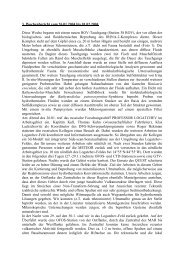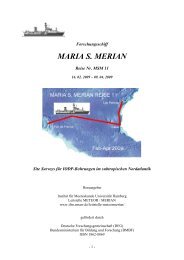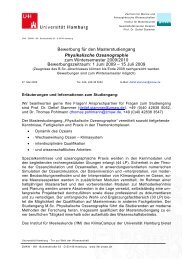MSM01_Expeditionsheft.pdf - Institute of Oceanography, University ...
MSM01_Expeditionsheft.pdf - Institute of Oceanography, University ...
MSM01_Expeditionsheft.pdf - Institute of Oceanography, University ...
Sie wollen auch ein ePaper? Erhöhen Sie die Reichweite Ihrer Titel.
YUMPU macht aus Druck-PDFs automatisch weboptimierte ePaper, die Google liebt.
Arbeitsprogramm <strong>MSM01</strong>/1a<br />
Warnemünde – Stockholm (16.2. – 25.2.)<br />
(Fahrtleiter Pr<strong>of</strong>. Dr. Klaus Jürgens)<br />
Über 10 Tage sollen im Bereich der Gotlandsee<br />
Arbeiten auf Stationen und Kartierungen<br />
durchgeführt werden. Zu Beginn<br />
werden Verankerungen von Sinkst<strong>of</strong>ffallen<br />
und ereignisgesteuerten bodennahen Partikelsammlern<br />
geborgen und neu ausgelegt.<br />
Eine Dauerstation von einem Tag im zentralen<br />
Gotlandbecken soll die Grundaufnahme<br />
für die physikalische Struktur und die Bestände<br />
von Nährsalzen, Kohlenst<strong>of</strong>fkomponenten,<br />
Organismen und molekularbiologischen<br />
Variablen liefern. Es sind Aufnahmen<br />
mit CTD-Rosette , Pump-CTD und in-situ<br />
Pumpen geplant. Danach sollen drei Transsekte<br />
über die Beckenränder und durch das<br />
zentrale Tief des Beckens mit dem um ein<br />
Boden-Video–Modul ergänzten Pump-CTD-<br />
System abgefahren und mittels Videoverfahren<br />
die geologischen Strukturen und die<br />
mikrobielle Besiedlung kartiert werden.<br />
Dieses Verfahren ermöglicht auch eine video-gestützte<br />
Probennahme in bodennahen<br />
Trübungsschichten. Gleichzeitig sollen Fächerlot<br />
und Sedimentecholote zum Einsatz<br />
kommen.<br />
Auf Grund dieser Kartierungen sollen anschließend<br />
typische Areale mit Multicorer<br />
und Loten beprobt werden, um mikrobielle<br />
Bedeckung und sedimentologische Grundmuster<br />
zu untersuchen und zu vergleichen.<br />
In einer engabständigeren Kartierung der<br />
Trübungsmaxima in der Wassersäule, die<br />
Indikatoren für die Lage der mikrobiellen<br />
und geochemischen Abfolge von Redoxprozessen<br />
in der Wassersäule sind, soll die Frage<br />
der lateralen räumlichen Homogenität<br />
dieser Prozesse geklärt werden. Gleichzeitig<br />
soll durch den Einsatz von Sedimentecholoten<br />
die engräumige geologische Struktur der<br />
Beckenregion erfaßt werden.<br />
Es schließt sich eine weitere Dauerstation<br />
für mikrobiologische Untersuchungen im<br />
Landsorttief an, das entgegen der<br />
Gotlandsee die anoxischen Bedingungen im<br />
Bodenwasser konstant über die letzten 10<br />
Jahre erhalten hat und daher als langfristig<br />
stabile Referenz gilt.<br />
- 11 -<br />
Working Program <strong>MSM01</strong>/1a<br />
Warnemünde – Stockholm (16.2. – 25.2.)<br />
(chief scientist Pr<strong>of</strong>. Dr. Klaus Jürgens)<br />
10 days <strong>of</strong> work will be done in the Gotland<br />
Sea, comprising station work and mapping.<br />
This will start with with retrieving and redeploying<br />
moorings fitted with sediment<br />
traps and event-controlled bottom near particle<br />
collectors. A 1 day time-series station<br />
in the central Gotland Basin will provide<br />
basic data to characterise water column<br />
physics and the inventories <strong>of</strong> nutrients,<br />
carbon components, organisms and microbiological<br />
variables. Sampling is planned<br />
with a CTD-rosette, Pump-CTD, and in situ<br />
pumps. Three transects across the basin<br />
fringes and the central deepest part will be<br />
serviced thereafter with a pump-CTD additionally<br />
fitted with a video module to map<br />
geological structures and the colonisation<br />
by microbial communities. This approach<br />
allows a video-controlled sampling within<br />
bottom-near nepheloid layers. In parallel<br />
multibeam and other sediment echo sounders<br />
will be operated.<br />
Based on this mapping representative areas<br />
will be sampled with multi-corer and other<br />
corers to investigate and compare microbial<br />
covers and basic sedimentological patterns.<br />
With a higher resolution mapping <strong>of</strong><br />
nepheloid maxima in the water column, indicative<br />
for the layering <strong>of</strong> microbial and<br />
geochemical redox processes, the question<br />
will be followed whether these processes are<br />
homogeneously distributed. This will be<br />
complemented by a survey with sediment<br />
echo sounders to assess the geological<br />
strcture <strong>of</strong> the basin region with a high spatial<br />
resolution.<br />
Another time-series station for microbiological<br />
variables will thereafter be sampled<br />
in the Landsort Deep. In contrast to the Gotland<br />
Deep, anoxia has been permanent here<br />
for 10 years which is why this region serves<br />
as a long-term stable reference.



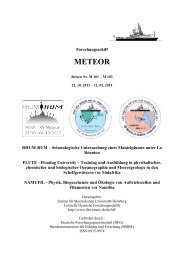

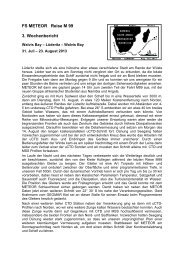
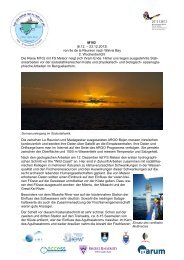
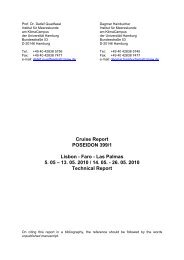
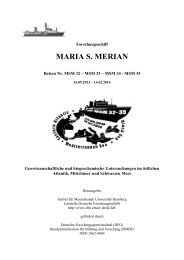
![Expeditionsheft Reisen M99-M100 [pdf] - Institute of Oceanography ...](https://img.yumpu.com/22533092/1/184x260/expeditionsheft-reisen-m99-m100-pdf-institute-of-oceanography-.jpg?quality=85)
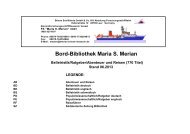
![Darstellungen [pdf]](https://img.yumpu.com/22533086/1/184x260/darstellungen-pdf.jpg?quality=85)
